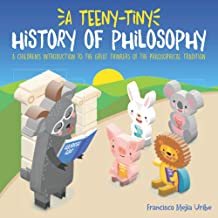A Teeny-Tiny History of Philosophy: A Children's Introduction to the Great Thinkers of the Philosophical Tradition by Francisco Mejia Uribe
“Teacher Socrates Goat had a problem: he wanted to live the good life, but didn’t know what the good life was.” So begins Francisco Mejia Uribe’s A Teeny-Tiny History of Philosophy: A Children’s Introduction to the Great Thinkers of the Philosophical Tradition, a book for children ages 5 and up.
It’s a picture book about cuddly critters. It’s also a book about big questions and ideas.
Twenty-five key figures from the history of philosophy are given animal form — such as Descartes Donkey and Kant Kangaroo — with simple, colorful, kid-friendly illustrations by the author. Sartre Sloth wears little round eyeglasses and Simone de Beaver has little eyelashes. Each character is presented in a combination of flat illustration and 3D forms not unlike novelty erasers, giving the images a fun, toy-like quality.
Each philosopher gets a quick overview touching on at least one major idea. Socrates Goat has his Socratic method, Plato Pig has his ideal forms, Bentham Bear has Utilitarianism, Hegel Hamster has his Dialectic. The characters appear chronologically right up to (Peter) Singer Sheep and his circle of caring. Most are characterized by one fundamental philosophical question and the answer they offer.
The ideas are boiled down to simple terms for the most basic level of understanding and greatest accessibility. The illustrations also encapsulate the ideas presented: a picture of a squirrel spray-painting a wall with graffiti that includes words like “toleration” and “individual liberty” is bound to lead a child to wonder what Spinoza Squirrel is doing and why.
A TEENY-TINY BACKSTORY
The project came about when Uribe, a philosopher and economist from Cali, Colombia, decided to try to create a philosophy book that his young daughter Maya could understand. He pursued this challenge in his spare time while stuck at home during the pandemic. He is also the author of what can be described as a companion series for younger children called Philosophy Friends!, in which each book centers on the ideas of a single philosopher. The series currently covers Plato Pig, (John) Rawls Rabbit, Wittgenstein Wolf, Philippa Fox (aka Philippa Foot), and (John Stuart) Mill Mouse. More titles in the series are forthcoming.
The Teeny-Tiny History of Philosophy is a unique book for a unique child — a wondering, curious child — with an ambitious parent who will doubtless be called upon to answer hundreds upon hundreds of precocious questions that this book will raise in a young person’s mind.
It’s an opportunity to not only get your child familiar with the history of philosophy but also to engage your child in conversation about how these big questions and ideas apply to their everyday experiences. With an adult along for the journey, even a very young child could be led by this book toward their first considerations of concepts like “truth” and “fairness.” There’s even a quiz at the end to help you get a sense of your child’s comprehension. The timeline at the front of the book is especially helpful as a review tool.
The fun characters and colorful illustrations will pique your child’s interest in the great philosophers, the questions they asked, and the ideas they developed. The Teeny-Tiny History of Philosophy is bound for longevity on your child’s bookshelf, serving as a book for browsing and reference until they move on to more substantive ones on the topic.
One can imagine it as the starting point for a lifetime of inquiry and wonder — or perhaps even the teeny-tiny spark that inspires the illuminating ideas of the next “great thinker.”





